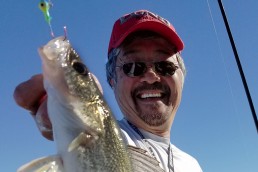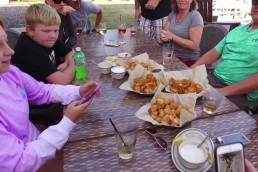‘Zone Fishing’ for More Walleyes and Saugers
SHARE THIS POST
As November rolls along, there is still time to head out to fish for fall walleyes and saugers available in tailwater areas below lock and dams along the Mississippi River and others. Unlike other times of the year, this season is perfect for increasing your success rate. You now have an opportunity to concentrate on what I call “Zone Fishing.”
When explaining zone fishing, it’s important to break the water you are fishing into three distinct depth ranges. What we are doing here is, depending on the depth of the location you are fishing, is breaking the depth into thirds. For example, let’s say you are fishing 15 feet of water. You are going to break that depth into 5-, 10- and 15-foot zones to concentrate your efforts on looking for the fish. You see, it’s very important to realize that in fall you will find the walleyes and saugers using different depths up near dams where they are looking for forage to eat. I find that many anglers make the big mistake in fall by just concentrating on the deeper depths closer to the bottom. Granted, you will at times find fish holding there, but you will also find just as good if not better concentrations of fish at other depths. By not realizing that these fish will suspend at different depths now, you will be missing many more that are very catchable as they’re looking for an easy meal.
When using the zone fishing method, the help of a good depth finder is surely a plus. By having electronics with a good resolution you can easily pinpoint the exact depths the fish are suspending at. This is 80 percent of the battle in catching these tailwater feeders. As we all know, you cannot catch them if you cannot locate them. Make it a point to set your resolution to a higher setting on the depth finder so that your unit will be more apt to locate tight, smaller schools of any suspended fish. The normal automatic resolution settings on many depth finders can miss fish due to a lack of a sensitive reading in this setting.
So, we’ve located those hungry walleyes and saugers that are just waiting to inhale our offerings, but what do we do now to catch them?
With the proper depth of the fish now at hand, it is a matter of placing the right presentation in a way so that they cannot resist. And nothing is going to beat a properly placed jig and live bait rig. Having it “properly placed” is important so that the lure and bait is in a location zone where those fish are feeding.
Are you enjoying this post?
You can be among the first to get the latest info on where to go, what to use and how to use it!
After picking out a jig from your selection and making sure it’s heavy enough to fish straight down in any current, you will want to tip that lure with a big, lively minnow for added attraction. Depending on what depth the fish are at that you’re targeting, you will want to let the lure out over the side of the boat and carefully let it sink into that zone I’ve been referring to. Maintain control of what the jig is doing as it’s falling through the water column. As you are letting it down you will want to note the depth of the suspended fish on your electronics and stop the jig either just above or even with where the fish are suspended. If you let the jig go past the fish, you’ll miss that fish zone and sharply decrease your chances of getting a bite. As I have mentioned in the past, the fish in the now colder waters will not move very far to chase bait. But if baits are placed near them, they will more often than not strike them so practice lure accuracy in the fish zone.
With your offering now in the proper location where fish are suspended, you can now use a slow lift-and-fall motion of the rod to give action to your jig. No fast movements needed here, just a slow, steady action. If you get no results, try changing your lift speed until the fish tell you what they prefer on that given day.
Fall tailwater angling is a real treat to behold. Dress for the weather, stay in the zones we’ve discussed and enjoy the moment as these fish are there and are hungry.
Email your outdoors questions to Mike Cyze at: lastcast13@yahoo.com. You can also check out his blog at: lastcastoutdoors.com or listen to him on ESPN Radio.
MWO
SHARE THIS POST
Did you enjoy this post?
You can be among the first to get the latest info on where to go, what to use and how to use it!
Mike Cyze
Mike Cyze has been called one of the most knowledgeable multispecies river anglers in the country. His ability to catch fish under the challenging conditions encountered in the river environment, combined with his overall fishing knowledge, has earned him recognition as a true Mississippi River Expert. Contact him at: lastcast13@yahoo.com.



